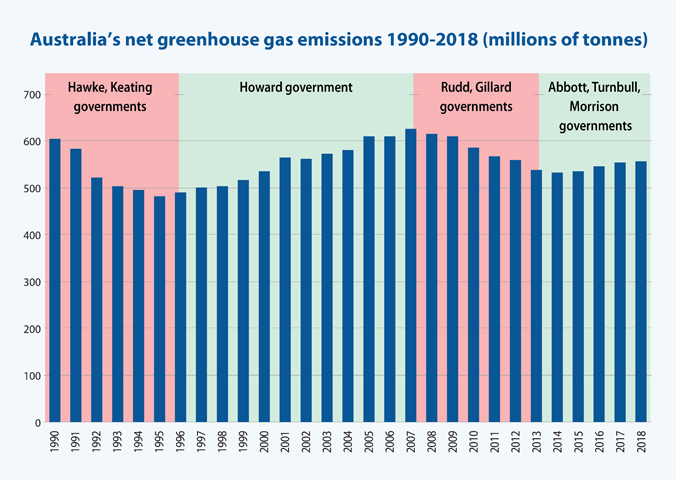The Coalition is running out of time to get its climate policies in order.

Angus Taylor, our newly-minted minister for energy and emissions reduction, is at a crossroads. The path he chooses will have a defining impact on emissions abatement and how this Morrison government will be remembered.
A fortnight ago Australia’s greenhouse gas inventory for 2019 was posted on the website of the United Nations Framework Convention on Climate Change.
Taylor made no mention of this two days later when he took up his new role in charge of emissions reduction; nor did Sussan Ley as the new minister for the environment.
The very first graph in the 1000-page report, depicting Australia’s net greenhouse gas emissions from 1990 to 2018, reveals four distinct trends: a downward trajectory from 1990 to 1995, then an upward one until 2007, then down again until 2014, and upward after that.
Students of political history will note that the four trends coincide quite closely with changes of government, from the Hawke-Keating years to John Howard, back to Labor and finally back to the Coalition. Emissions seem to rise under the Coalition and fall under Labor.
A lot of the trending has little to do with the party in government. An economic recession and less land clearing in the early 1990s brought emissions down before a mining boom pushed them up again. They turned downward again when the global financial crisis hit in 2007-08.
But the present upward trend dates from when Tony Abbott’s government repealed Julia Gillard’s pilloried carbon tax and replaced it with “Direct Action”, a policy that seemed headed for oblivion before it was revived under Scott Morrison.
Under this policy, the government uses public money to buy carbon abatement in various forms, mainly by paying farmers and others to plant trees and avoid land clearing. According to the government’s own data, this has had no impact on emissions.
Australia’s report for the December 2018 quarter, which emerged last week nearly six months after the event, is another sorry story. In 2018 emissions rose 0.7 per cent, or 3.5 million tonnes, with a better performance in electricity and agriculture wiped out by increases everywhere else.
Quizzed about the exceptionally late release of the December data, Taylor said he needed time to settle into his new job. No mention of the possibility that at least some people who returned the Morrison government might have valued that information ahead of voting.
Taylor’s message about the data was that emissions per capita were down (unsurprisingly since Australia’s population is growing strongly), that emissions intensity was down (good, but that doesn’t help our Paris goals), and that by exporting more low-emitting gas we were helping the world lower coal consumption – something we were not being given credit for.
Say that again? The Morrison government is helping the world break away from coal? But hasn’t it been arguing that the world needs our coal? Isn’t that why it won seats in the sunshine state?
We are having two parallel conversations about emissions. Most observers focus on the amount of carbon Australia and the world is sending into the atmosphere, but the government talks only of “saved” emissions, expressing its Paris 2030 target as a plan for 328 megatonnes of abatement.
The government’s emissions reduction plan depends heavily on trees, but new seedlings, if they survive, can only affect emissions many years ahead. Megatonnes of abatement turn out to be a bit like future budget surpluses – easy to talk about but of no value until the time arrives.
Today’s figures say clearly that Tony Abbott’s purchased abatement strategy, overseen by ministers Greg Hunt, Josh Frydenberg and Melissa Price, simply hasn’t worked. Assuming he grasps that awkward truth, Angus Taylor’s main task is to bring something new to the table.
Climate policy has been the victim of party politics ever since Abbott defeated Malcolm Turnbull in a Liberal leadership ballot in 2009 on the basis of his firm opposition to any form of carbon price signal. Even before he entered parliament in 2013, Taylor was on Abbott’s side.
But Turnbull’s National Energy Guarantee, which includes a pricing mechanism, is now the only viable option for Taylor. Somehow, a minister who once campaigned against carbon pricing and renewables must persuade the Coalition to support both, while turning down the volume over coal.
As climate change looms ever-larger as a public issue, time is not on the side of Angus Taylor and Scott Morrison. Errors by Labor, some astute campaigning and a slice of luck have given the Coalition a third chance to get things right. There won’t be a fourth one.
Taylor was all too ready to repeat the spin of his predecessors last week, but staying the course is out of the question. For all our sakes, the government has to make a fresh start, now.
